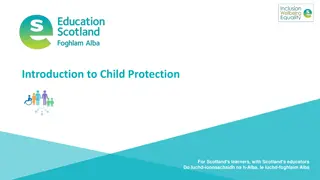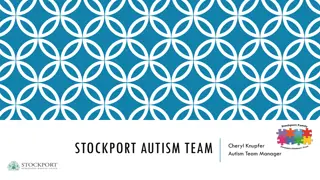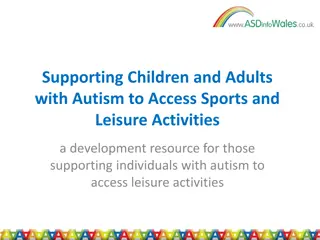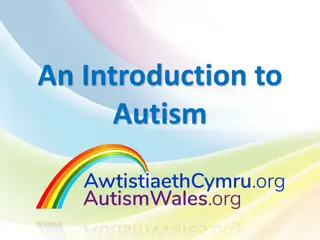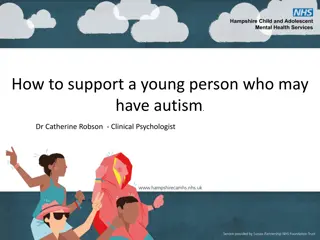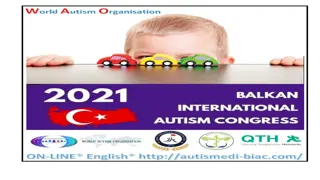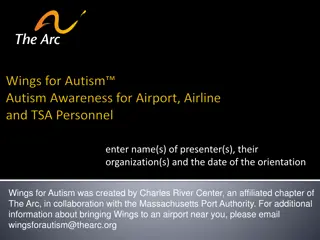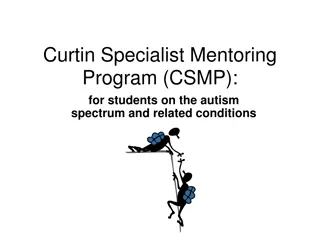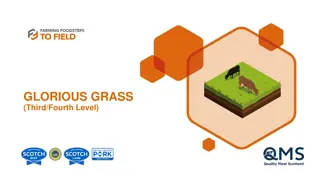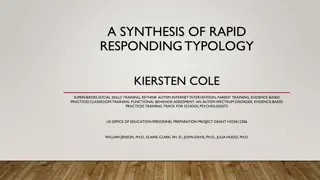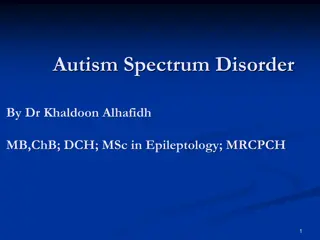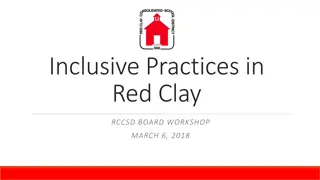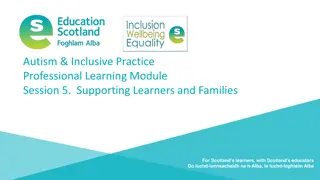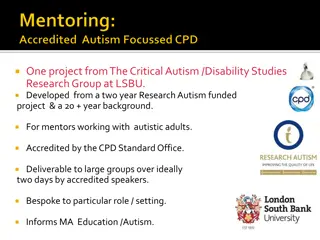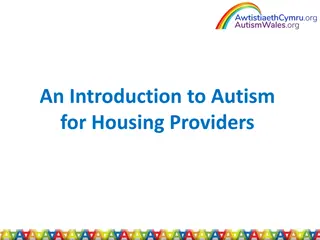Understanding Autism: Enhancing Inclusive Practices in Scotland
Explore the diverse facets of autism in the educational landscape of Scotland through this professional learning module. Delve into terminology, Scottish context, cognitive theories, communication strategies, and supporting tools to cater to autistic learners effectively. Gain insights on core features, causes, prevalence, and cognitive theories related to autism, along with practical tips for nurturing communication and addressing sensory differences. Enhance your understanding to create an inclusive environment for learners with autism.
- Autism Awareness
- Educational Inclusion
- Communication Strategies
- Scotland Educators
- Cognitive Theories
Download Presentation

Please find below an Image/Link to download the presentation.
The content on the website is provided AS IS for your information and personal use only. It may not be sold, licensed, or shared on other websites without obtaining consent from the author. Download presentation by click this link. If you encounter any issues during the download, it is possible that the publisher has removed the file from their server.
E N D
Presentation Transcript
Autism & Inclusive Practice Professional Learning Module Session 3. Understanding Autism For Scotland's learners, with Scotland's educators Do luchd-ionnsachaidh na h-Alba, le luchd-foghlaim Alba
This weeks session This week s session 1. Terminology 2. The Scottish context for autism and inclusion 3. Understanding Autism 4. Assessment and Monitoring 5. Supporting Learners and Families 6. Social and Emotional Wellbeing 7. Transitions
Recap of Section 3 Recap of Section 3 Understanding Autism Understanding Autism 3.1 3.2 3.3 3.4 3.5 3.6 3.7 3.8 What is autism? Cognitive theories - overview Communication and autism Supporting communication Environment Sensory differences Supporting autistic learners in an educational setting Autism and anxiety
3.1 What is autism? 3.1 What is autism? The word spectrum The definition of autism Prevalence Core features Causes Autism in males and females The Professional Development section on the Toolbox has a range of films you can watch which focus on the causes of autism and girls and autism.
3.2 Cognitive theories 3.2 Cognitive theories - - overview overview Theory of mind Weak executive function Weak central coherence Context blindness Double empathy problem Monotropism
3.3 Communication and autism 3.3 Communication and autism Pre-intentional v. intentional Stages of communication Variability Social communication Eye contact Joint attention Prosody and accent Body language Prosopagnosia Comprehension
3.4 Supporting communication 3.4 Supporting communication Key strategies Technology
3.4 Supporting communication 3.4 Supporting communication http://www.autismtoolbox.co.uk/communication-supports-aac https://www.autism.org.uk/what-we-do/campaign/public- understanding/too-much-information
3.4 Supporting communication 3.4 Supporting communication Expressive language Social communication Metacognition Peers Masking and camouflaging
Activity 8 Activity 8
3.5 3.5 Environment Environment Physical environment Social environment Routines
3.6 3.6 Sensory differences Sensory differences
Activity 9 Activity 9 Thoughts about sensory differences for Autism Toolbox - YouTube
3.7 3.7 Supporting autistic learners in an educational Supporting autistic learners in an educational setting setting Inclusive learning environments Inclusive classrooms Collaborative support
Activity 10 Activity 10
3.7 3.7 Supporting autistic learners in an Supporting autistic learners in an educational setting educational setting How to use a Safe Space Other adjustments NAIT Safe Space Guidance
3.8 Autism and anxiety 3.8 Autism and anxiety Autism and anxiety Signs of anxiety
Activity 11 Activity 11
3.8 Autism and anxiety 3.8 Autism and anxiety Anxiety build up Supporting learners with social anxiety Supporting learners with social anxiety
Activity 12 Activity 12
Gap Task Gap Task Complete sections: 4. Assessment and Monitoring Reflective Log: Activity 8, page 11 Activity 10, page 12 Activity 12, page 13
Next session Next session 1. Terminology 2. The Scottish context for autism and inclusion 3. Understanding Autism 4. Assessment and Monitoring 5. Supporting Learners and Families 6. Social and Emotional Wellbeing 7. Transitions
Education Scotland Denholm House Almondvale Business Park Almondvale Way Livingston EH54 6GA T +44 (0)131 244 5000 E enquiries@educationscotland.gsi.gov.uk For Scotland's learners, with Scotland's educators






